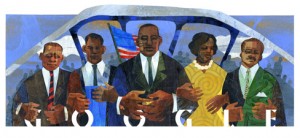Good morning, Whitewater.
Happy King Day. We’ll have mild temperatures in Whitewater, with a high of thirty-six. Sunrise is 7:19 and sunset 4:51 PM, for 9h 31m 46s of daytime. The moon is a waning crescent, with just 1.5% of its visible disk illuminated.

Google’s doodle for King Day links to useful information about his work and ongoing legacy.
On this day in 1937, industrialist and aviator Howard Hughes sets a transportation record for the time:
All landplane distance speed records were broken yesterday by Howard Hughes, millionaire sportsman pilot, who reached Newark Airport 7 hours 28 minutes and 25 seconds after he took off from Los Angeles, Calif. He was then forced to stay aloft until the runway at the field was clear and landed at 1:03 P. M. His average speed was 332 miles an hour for the 2,490 miles he traveled.
Grimy from the smoke of his exhaust stacks the lanky pilot climbed out of his cramped cockpit and grinned. In recounting his experiences on the flight he said that the skies were overcast all the way and he had to fly on top of the clouds. He saw the ground only twice west of the Ohio Valley, once at Winslow, Ariz. and again as he roared across the Mississippi River.
It was 2:14 o’clock in the morning and pitch dark when opened the throttle at the Union Air Depot at Burbank and released the 1,100 horsepower sealed in the fourteen cylinders of his supercharged Twin Row Wasp engine. The sleek gray and blue low-winged monoplane, designed and built under his own direction, staggered, accelerated and then literally vaulted into the air. Within a few seconds Hughes climbed into low-hanging clouds swung eastward and headed for the San Bernardino Pass.
At 14,000 feet, at which altitude he flew most of the way, he passed over the clouds, set his course and leveled off. He throttled his engine back until it was delivering only 375 horsepower and hunched himself over his instrument panel.
He was wearing a new type oxygen mask for high altitude flying. With nothing to see except the top of the cloud stratum he began experimenting with it. He finally adjusted it so that it fed too much air and not enough oxygen and he began to feel faint. Over the Sierras he had fears for a moment that his attempt might not be a success, but at last re-adjusted the mask so that the gas revived him.
On this day in 1939, in Fort Atkinson, a different kind of record:
1939 – Chicken Plucking World Record
On January 19, 1939 Ernest Hausen (1877 – 1955) of Ft. Atkinson set the world’s record for chicken plucking. [Source: Guiness Book of World’s Records, 1992]
Google-a-Day asks a question about geography:
What explorer first visited the U.S. river, which is the largest within its state, creating a natural boundary with Mexico?
